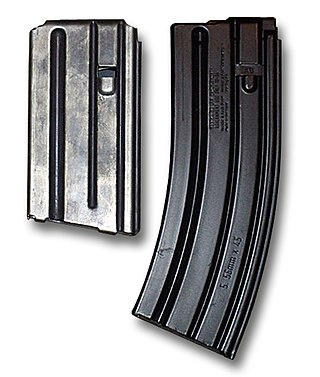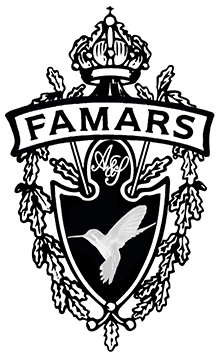This article needs additional citations for verification .(October 2020) |
Vincenzo Bernardelli S.p.A. (also referred to as Bernardelli) was an Italian firearms manufacturing company, founded in 1721 by Vincenzo Bernardelli.
This article needs additional citations for verification .(October 2020) |
Vincenzo Bernardelli S.p.A. (also referred to as Bernardelli) was an Italian firearms manufacturing company, founded in 1721 by Vincenzo Bernardelli.
The origins of the Bernadelli family's involvement in the firearms business can be traced to 1631, when Bernadelli forebear Bartolino Barnelli married into the noble Acquisti family which owned several gun factories in Gardone Val Trompia at Brescia, Italy. In the following year, Bartolino's sister would marry his wife's brother to further seal the tie between the two families. Sometime between 1632 and 1721, the Barnelli family name changed to Bernardelli. [1] In 1721, some Bernardelli brothers are recorded to have bought a large gun factory in Gardone Val Trompia.
The proper genesis of the gun company that would bear his namesake, would begin with Vincenzo Bernardelli (birthdate unknown). Vincenzo Bernardelli learned gun-making as an employee of the Franzini Arms Factory, that at the time, was one of the most important firearms manufacturers in Gardone Val Trompia. Working in company, Bernardelli would eventually become chief of the Damascus twist shotgun barrel division.
In 1865, Vincenzo Bernardelli would branch out from the Franzini Arms Factory and would start his own firearms business. [2] He founded a large factory with water-powered machinery, which served as the institution to his firearm company. The Bernardelli company utilized water to power its machinery right up to the end of the 20th century.
As at Franzini Arms Factory, Vincenzo Bernardelli originally made Damascus twist shotgun barrels. In the following decade, he would start making complete firearms in limited numbers. He would be joined by his four sons, whom each were assigned a particular role in manufacturing process. The firm soon outgrew its original quarters and began a search for better facilities and room for expansion. In 1899 Vincenzo Bernardelli died and the management was taken over completely by his capable sons. [3]
In 1908 a large textile factory became available for purchase and was secured by the brothers. Following World War I the factory was modernized yet again.
The company entered commercial sporting arms market in 1928 proper. [4] From 1928 to 1933, the company was one of many Italian firearm companies that manufactured the 10.4mm Italian service revolver, the Bodeo Model 1889. [5] This was the first handgun their company produced, with a total production in excess of 25,000. [3]
During World War II the company began manufacturing artillery fuses, which the company would produce up until 1986.
Following World War II the plant was again expanded and newer machinery and manufacturing methods were installed. The company started to offer differing types of firearms in their line-up, from automatic pistols and automatic rifles. Their first self-loading pistol was the VP (Vest Pocket) Model, which was based on the Walther Model 9.
In 1980s, Bernardelli acquired license to manufacture quantities of the IMI Galil assault rifle in two different models for governmental use. [6] [7] Their domestically produced rifles, including a special variant able to accept NATO STANAG magazines, were entered to the 1988/1989 rifle trials conducted by Italian Armed Forces in search for a Beretta BM59 replacement. Ultimately, the Beretta AR70/90 would be chosen as Army's new standard assault rifle. [6] [8]
In 1997 the V. Bernardelli company was forced into bankruptcy and its assets, brands, and trademarks were acquired by the Turkish Sarsılmaz Arms. [3]


Besides firearms manufacture, Bernardelli has also manufactured components for Alfa Romeo aircraft engines in the late 1920s. [3]
In the Trigun manga series and its 1998 anime adaptation, the Bernardelli Insurance Society is a reference to Bernardelli firearms.

The IMI Galil is a family of Israeli-made automatic rifles chambered for the 5.56×45mm NATO and 7.62×51mm NATO cartridges. Originally designed by Yisrael Galili and Yakov Lior in the late 1960s, the Galil was first produced by the state-owned Israel Military Industries and is now exported by the privatized Israel Weapon Industries.

Fabbrica d'Armi Pietro Beretta is a privately held Italian firearms manufacturing company operating in several countries. Its firearms are used worldwide for a variety of civilian, law enforcement, and military purposes. Sporting arms account for three-quarters of sales; Beretta is also known for marketing shooting clothes and accessories. Founded in 1526, Beretta is the oldest active firearm manufacturer as well as one of the oldest continuously operating companies in the World. Its inaugural product was the arquebus barrel; by all accounts Beretta-made barrels equipped the Venetian fleet at the Battle of Lepanto in 1571. Beretta has supplied weapons for every major European war since 1650.

Israel Weapon Industries (IWI), formerly the Magen division of the Israel Military Industries Ltd. (IMI), is an Israeli firearms manufacturer.

The Beretta Model 1934 is an Italian compact, semi-automatic pistol which was issued as the service pistol of the Royal Italian Army beginning in 1934. As the standard sidearm of the Italian army it was issued to officers, NCOs and machine gun crews. It is chambered for the 9mm Corto, more commonly known as the .380 ACP.

Gardone Val Trompia is a town and comune in the province of Brescia, in Lombardy, northern Italy. It is bounded by the comunes of Marcheno and Sarezzo. It is located in the Trompia valley. Gardone received the honorary title of city with a presidential decree on 21 September 2001.
A. Uberti S.p.A., is an Italian manufacturer of high quality replicas of 19th century American percussion revolvers, carbines, and rifles as well as cartridge revolvers, single-shot rifles, and lever-action rifles. These replicas are commonly used by historical re-enactors, participants in action shooting sports such as cowboy action shooting, working ranchers and target shooters who prefer traditional-style firearms. Thanks to their quality, Uberti replicas are also sought after by collectors and historical firearm enthusiasts.

Muzzleloading is the shooting sport of firing muzzleloading guns. Muzzleloading guns, both antique and reproduction, are used for target shooting, hunting, historical re-enactment and historical research. The sport originated in the United States in the 1930s, just as the last original users and makers of muzzleloading arms were dying out. The sport received a tremendous boost in the 1960s and 1970s. The Muzzle Loaders Associations International Committee (www.MLAIC.org) was formed in 1970 and held its first World Championship in 1971. Since then a flourishing industry manufacturing working reproductions of historic firearms now exists in the United States and Europe, particularly in northern Italy, for example at Gardone Val Trompia, in the Province of Brescia. In the United States muzzleloading guns are, subject to a number of qualifications, generally not considered firearms. Subject to state law they may be possessed by persons who might otherwise not be legally allowed to own a firearm.
Armi Jager, otherwise known as Adler Jager, was a German-Italian firearms manufacturer located in the small town of Loano, Italy.
Crause was a weapons manufacturer located in Herzberg, Germany, operating in the first half of the 19th century. Among other orders, they manufactured 2,000 M1849 kammerladers for the Norwegian Army.
The Beretta DT10, or the Beretta DT11, is an over and under shotgun. It was manufactured, marketed, and distributed by Fabbrica d'Armi Pietro Beretta, in Gardone Val Trompia, Italy. It is one of the few Beretta shotguns that has a trigger unit that is detachable in the field, the DT in its name standing for detachable trigger. It combines features between the older Beretta ASE and the newer Beretta 682 model and is targeted at their competition market.

The Beretta AR70/90 is a gas operated assault rifle chambered for the 5.56×45 mm NATO cartridge, and is the standard issue service rifle of the Italian Armed Forces. The weapon is also designed to be fitted with a rifle grenade, and has grenade sights. The AR series comes in many variants such as the AR90, with a wire folding stock, for use by paratroopers.

A STANAG magazine or NATO magazine is a type of detachable firearm magazine proposed by NATO in October 1980. Shortly after NATO's acceptance of the 5.56×45mm NATO rifle cartridge, Draft Standardization Agreement (STANAG) 4179 was proposed in order to allow NATO members to easily share rifle ammunition and magazines down to the individual soldier level. The U.S. M16 rifle's magazine proportions were proposed for standardization. Many NATO members, but not all, subsequently developed or purchased rifles with the ability to accept this type of magazine. However, the standard was never ratified and remains a "Draft STANAG".
The Beretta Silver Pigeon is a double-barreled shotgun. It is an over and under gun, with one barrel above the other. It is most often used for hunting birds and for clay target games such as trap and skeet. There are several models in field and sporting, for example 683, 686, and 687, with different features and finishes, and in various gauges.

Kalashnikov rifles, also known as the AK platform, AK rifles or simply the AK, are a family of assault rifles based on Mikhail Kalashnikov's original design. They are officially known in Russian as avtomat Kalashnikova, and informally as "kalash" in Russian. They were originally manufactured in the Soviet Union, by Kalashnikov Concern. Rifles similar to the Kalashnikov and its Soviet variants were later produced in many countries friendly to the Soviet Bloc, with rifles based on its design such as the Galil ACE and the INSAS also being produced. The Kalashnikov is one of the most widely used firearms in the world, with an estimated 72 million rifles in global circulation.

The Beretta ARX160 is an Italian modular assault rifle manufactured by Beretta. Developed for the Italian Armed Forces as part of the Soldato Futuro program, the ARX160 was launched in 2008 as a commercial weapon system independent from the Soldato Futuro ensemble, complete with a companion single-shot 40×46mm NATO low-velocity grenade launcher, called the GLX160, which can be mounted underneath the rifle or used with an ad hoc stock system as a stand-alone weapon.

The Bodeo Model 1889 was an Italian revolver named after the head of the Italian firearm commission, Carlo Bodeo. It was produced by a wide variety of manufacturers between 1889 and 1931 in both Spain and Italy. The Bodeo was employed by the Royal Italian Army in World War I, the Interwar Italian colonial wars, and World War II. The Bodeo was manufactured in three distinct varieties, the Tipo A for Enlisted soldiers, the Tipo B for Officers.
Davide Pedersoli & C. is an Italian firearms manufacturing company based in Gardone Val Trompia, Italy, that was founded in 1957 by Davide Pedersoli.

FAMARS, or Fabbrica Armi d’Abbiatico e Salvinelli, is an Italian gunmaker that manufactures bespoke shotguns and rifles. The company is best known for its patented detachable-lock designs and handcrafted woodwork and engraving. FAMARS is considered one of the top Italian gun manufacturers.

Bartolomeo Beretta, known as maestro di canne, was an Italian artisan from Lombardy who, by 1526, had established the arms manufacturing enterprise Beretta.